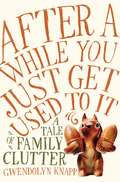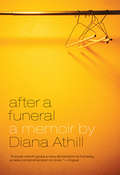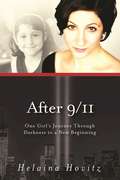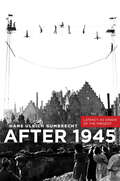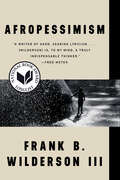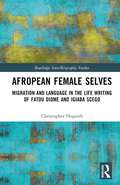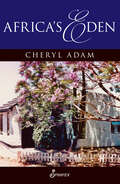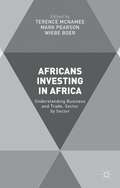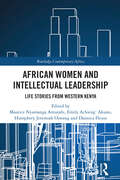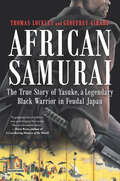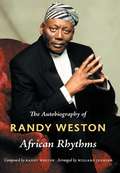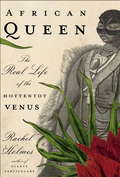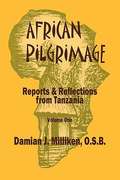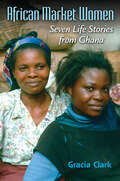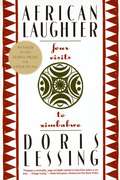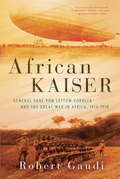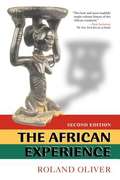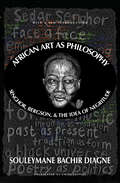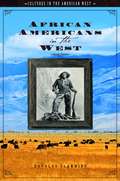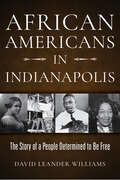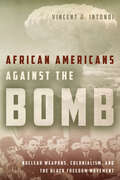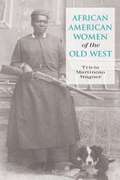- Table View
- List View
After a While You Just Get Used to It
by Gwendolyn KnappA vibrant new voice ups the self-deprecating memoir ante with tragicomic tales of her dysfunctional life in swampland Florida and America's Big Easy A dive bar palm reader who calls herself the Disco Queen Taiwan; a slumlord with a penis-of-the-day LISTSERV; and Betty, the middle-aged Tales of the Cocktail volunteer who soils her pants on a party bus and is dealt with in the worst possible way. These are just a few of the unforgettable characters who populate Gwendolyn Knapp's hilarious and heartbreaking--yet ultimately uplifting--memoir debut, After a While You Just Get Used to It. Growing up in a dying breed of eccentric Florida crackers, Knapp thought she had it rough--what with her pack rat mother, Margie; her aunt Susie, who has fewer teeth than prison stays; and Margie's bipolar boyfriend, John. But not long after Knapp moves to New Orleans, Margie packs up her House of Hoarders and follows along. As if Knapp weren't struggling enough to keep herself afloat, working odd jobs and trying to find love while suffering from irritable bowel syndrome, the thirty-year-old realizes that she's never going to escape her family's unendingly dysfunctional drama. Knapp honed her writing chops and distinctive Southern Gothic-humor style writing short pieces and participating in the renowned reading series Literary Death Match. Now, like bestselling authors Jenny Lawson, Laurie Notaro, and Julie Klausner before her, Knapp bares her sad and twisted life for readers everywhere to enjoy.
After a Funeral: A Memoir
by Diana AthillA classic memoir by the author of the New York Times bestseller Somewhere Towards the End. When Diana Athill met the man she calls Didi, she fell in love instantly and out of love just as fast. Didi's quirks, which at first appeared so charming and sweet, soon revealed a darker side--he was a gambler, a drinker, and a womanizer, impossible to live with but impossible to ignore. After a Funeral explores the years of their friendship; a period that culminated in Didi's suicide (in Athill's apartment). This bravura work "gives a new dimension to honesty, a new comprehension to love" (Vogue).
After 9/11: One Girl's Journey through Darkness to a New Beginning
by Helaina Hovitz Jasmin Lee Cori“You are a herald for your generation....Thank you for using your voice to help us make sense of that dark day, and forge a new beginning.”—Hillary Rodham Clinton, in a letter to Helaina Hovitz Helaina Hovitz was twelve years old and in middle school just blocks away when the World Trade Center was attacked. Her memoir encapsulates the journey of a girl growing up with PTSD after living through the events firsthand. After 9/11 chronicles its effects on a young girl at the outset of adolescence, following her as she spirals into addiction and rebellion, through loss, chaos, and confusion.The events of 9/11 were a very real part of Helaina’s life and are still vivid in her memory today. Hundreds were stranded in the neighborhood, including Helaina, without phones or electricity or anyone to help. Fear and despair took over her life. It would take Helaina more than a decade to overcome the PTSD — and subsequent alcohol addiction — that went misdiagnosed and mistreated. In many ways, After 9/11 is the story of a generation growing up in the aftermath of America’s darkest day —and for one young woman, it is the story of a survivor who, after witnessing the end, got to make a new beginning. This new trade paperback edition includes tips on how to cope with trauma, an FAQ section, and a guide to discussing 9/11 with children. “Inspirational, courageous and beautifully told. After 9/11 is a testament to the resiliency of the human spirit.” — Cathy Free, correspondent, PEOPLE magazine“Helaina Hovitz's engrossing narrative begins in the shadow of the twin towers with her as a backpack-toting twelve-year-old and plays out over the next fifteen years in dramatic - and sometimes distressing - detail. This impressive debut is both deeply evocative and intensely personal.” — Peter Canby, Senior Editor, The New Yorker“A moving and remarkable testament to a time that changed our country, told beautifully by a young woman who never gave up hope that she could reclaim her life, no matter how grim things looked.” — Sean Elder, contributor, Newsweek
After 1945: Latency as Origin of the Present
by Hans Ulrich GumbrechtWhat is it the legacy that humankind has been living with since 1945? We were once convinced that time was the agent of change. But in the past decade or two, our experience of time has been transformed. Technology preserves and inundates us with the past, and we perceive our future as a set of converging and threatening inevitabilities: nuclear annihilation, global warming, overpopulation. Overwhelmed by these horizons, we live in an ever broadening present. In identifying the prevailing mood of the post-World War II decade as that of "latency," Gumbrecht returns to the era when this change in the pace and structure of time emerged and shows how it shaped the trajectory of his own postwar generation. Those born after 1945, and especially those born in Germany, would have liked nothing more than to put the catastrophic events and explosions of the past behind them, but that possibility remained foreclosed or just out of reach. World literatures and cultures of the postwar years reveal this to have been a broadly shared predicament: they hint at promises unfulfilled and obsess over dishonesty and bad faith; they transmit the sensation of confinement and the inability to advance. After 1945 belies its theme of entrapment. Gumbrecht has never been limited by narrow disciplinary boundaries, and his latest inquiry is both far-ranging and experimental. It combines autobiography with German history and world-historical analysis, offering insightful reflections on Samuel Beckett and Paul Celan, detailed exegesis of the thought of Martin Heidegger and Jean Paul Sartre, and surprising reflections on cultural phenomena ranging from Edith Piaf to the Kinsey Report. This personal and philosophical take on the last century is of immediate relevance to our identity today.
Afropessimism
by Frank B. Wilderson III“Wilderson’s thinking teaches us to believe in the miraculous even as we decry the brutalities out of which miracles emerge”—Fred Moten Praised as “a trenchant, funny, and unsparing work of memoir and philosophy” (Aaron Robertson,?Literary Hub), Frank B. Wilderson’s Afropessimism arrived at a moment when protests against police brutality once again swept the nation. Presenting an argument we can no longer ignore, Wilderson insists that we must view Blackness through the lens of perpetual slavery. Radical in conception, remarkably poignant, and with soaring flights of memoir, Afropessimism reverberates with wisdom and painful clarity in the fractured world we inhabit.“Wilderson’s ambitious book offers its readers two great gifts. First, it strives mightily to make its pessimistic vision plausible. . . . Second, the book depicts a remarkable life, lived with daring and sincerity.”—Paul C. Taylor, Washington Post
Afropean Female Selves: Migration and Language in the Life Writing of Fatou Diome and Igiaba Scego (Routledge Auto/Biography Studies)
by Christopher HogarthAfropean Female Selves: Migration and Language in the Life Writing of Fatou Diome and Igiaba Scego examines the corpus of writing of two contemporary female authors. Both writers are of African descent, live in Europe and write about lives across Europe and Africa in different languages (French and Italian). Their work involves episodes from their lived experience and complicates Western understandings of life writing and autobiography. As Hogarth shows in this study, the works of Diome and Scego encapsulate the new and complex identities of contemporary "Afropeans." As an identity coined and used frequently by prominent authors and critics across Europe, Africa and North America, the notion of "Afropean" is at the cutting edge of cultural analyses today. Yet each writer occupies unique and different positions within this debated category. While Scego is a "post-migratory subject" in postcolonial Europe, Diome is an African writer who has migrated to Europe in her adult life. This book examines the different trajectories and packaging of these two specific postcolonial writers in the Francophone and Italophone contexts, pointing out how and where each author practices life writing strategies and scrutinizing the trend that emphasizes the life writing, autofictional, or autoethnographic strategies of African diasporic writers. Afropean Female Selves offers a comparative study across two languages of a notion that has so far been explored mainly in English. It explores the contours of this new discursive category and positions it in regard to other notions of Afrodiasporic identity, such as Afropolitan and Afro-European.
Africa's Eden
by Cheryl AdamAs a young unmarried mother in the 1960s, Maureen faces stifling disapproval and condemnation from mainstream society. Desperate to create a new life for herself and her baby, she rekindles an old romance and moves to South Africa under Apartheid. But her precarious journey to Africa's Eden is not the paradise she anticipated. Cultures smash against each other, family relationships are strained, there is death and despair, violence and injustice. But there is also humour, fun, family and friendship, as Maureen has to decide where her future lies. Is it here in Africa or back home in distant Eden, in her Australian homeland?
Africans Investing in Africa
by Terence Mcnamee Mark Pearson Wiebe BoerAfricans Investing in Africa explores intra-African trade and investment by showing how, where and why Africans invest across Africa; to identify the economic, political and social experiences that hinder or stimulate investment; and to highlight examples of pan-African investors. This book is the outcome of a project conceived in 2011 by the Johannesburg-based Brenthurst Foundation and the Lago-based Tony Elumelu Foundation. The foundations, drawing on their established record of scholarship and policy advice on issues impacting Africa's economic growth and development, agreed to undertake in-depth, case-study based research into why African-owned or/and African-based companies were still struggling to succeed across multiple geographies on the continent, despite the Africa's impressive economic growth rates and overall improvements in macro-economic management.
Africans in the Old South: Mapping Exceptional Lives across the Atlantic World
by Randy J. SparksThe Atlantic slave trade was the largest forced migration in history, yet most of its stories are lost. Randy Sparks examines the few remaining reconstructed experiences of West Africans who lived in the South between 1740 and 1860. Their stories highlight the diversity of struggles that confronted every African who arrived on American shores.
African Women and Intellectual Leadership: Life Stories from Western Kenya (ISSN)
by Maurice Nyamanga Amutabi Emily Achieng’ Akuno Humphrey Jeremiah Ojwang Dannica FleussThis book highlights the pioneering roles of African women as leaders and role models in Kenya, providing examples taken from across education, health, business, and a range of other sectors. Drawing on authentic first-hand accounts and narratives from key women in leadership positions, and those who have lived with them, the book presents the life stories of women leaders over the last fifty years, aiming to preserve their contributions for posterity and to inspire young people with moral, ethical, and progressive role models. The book uses African knowledge production strategies that look at the human being holistically, in the prism of Ubuntu, in order to define leadership in Africa from an African perspective, one that celebrates the role of the mother figure and places women at the centre of African values and societal dynamics. This book will be of interest to researchers and students of African studies, gender studies, and Kenyan education and socio-political history.
African Women: Three Generations
by Mark Mathabane"This gripping saga by the author of Kaffir Boy presents a truthful, passionate, and illuminative biography of his great-grandmother, grandmother, and mother in South Africa. Mathabane vividly describes the shocking, heartbreaking stories of each generation of women as they struggle for independent incomes to support themselves and their children; while resisting apartheid, they must also resist the traditions imposed by their own society and the oppresion imposed by their men. The stories are an inspiration and tribute to millions of women worldwide in similar conditions. A thought-provoking book that is sure to deliver a strong message all who read it."--From Libary Journal
African Traveler: The Story of Mary Kingsley
by Ronald SymeAfrican Traveler: The Story of Mary Kingsley by Ronald Syme
African Samurai: The True Story of a Legendary Black Warrior in Feudal Japan
by Geoffrey Girard Thomas LockleyWarrior. Samurai. Legend.“A readable, compassionate account of an extraordinary life.” —The Washington PostThe remarkable life of history’s first foreign-born samurai, and his astonishing journey from Northeast Africa to the heights of Japanese society.When Yasuke arrived in Japan in the late 1500s, he had already traveled much of the known world. Kidnapped as a child, he had ended up a servant and bodyguard to the head of the Jesuits in Asia, with whom he traversed India and China learning multiple languages as he went. His arrival in Kyoto, however, literally caused a riot. Most Japanese people had never seen an African man before, and many of them saw him as the embodiment of the black-skinned (in local tradition) Buddha. Among those who were drawn to his presence was Lord Nobunaga, head of the most powerful clan in Japan, who made Yasuke a samurai in his court. Soon, he was learning the traditions of Japan’s martial arts and ascending the upper echelons of Japanese society.In the four hundred years since, Yasuke has been known in Japan largely as a legendary, perhaps mythical figure. Now African Samurai presents the never-before-told biography of this unique figure of the sixteenth century, one whose travels between countries, cultures and classes offers a new perspective on race in world history and a vivid portrait of life in medieval Japan.
African Rhythms: The Autobiography of Randy Weston
by Randy WestonThe pianist, composer, and bandleader Randy Weston is one of the world's most influential jazz musicians and a remarkable storyteller whose career has spanned five continents and more than six decades. Packed with fascinating anecdotes, African Rhythms is Weston's life story, as told by him to the music journalist Willard Jenkins. It encompasses Weston's childhood in Brooklyn's Bedford-Stuyvesant neighborhood--where his parents and other members of their generation imbued him with pride in his African heritage--and his introduction to jazz and early years as a musician in the artistic ferment of mid-twentieth-century New York. His music has taken him around the world: he has performed in eighteen African countries, in Buddhist temples and Shinto shrines, in the Canterbury Cathedral, and at the grand opening of the Bibliotheca Alexandrina: The New Library of Alexandria. Africa is at the core of Weston's music and spirituality. He has traversed the continent on a continuous quest to learn about its musical traditions, produced its first major jazz festival, and lived for years in Morocco, where he opened a popular jazz club, the African Rhythms Club, in Tangier. Weston's narrative is replete with tales of the people he has met and befriended, and with whom he has worked. He describes his unique partnerships with Langston Hughes, the musician and arranger Melba Liston, and the jazz scholar Marshall Stearns, as well as his friendships and collaborations with Duke Ellington, Dizzy Gillespie, Coleman Hawkins, Thelonious Monk, Billy Strayhorn, Max Roach, Charlie Parker, Miles Davis, the novelist Paul Bowles, the Cuban percussionist Candido Camero, the Ghanaian jazz artist Kofi Ghanaba, the Gnawa musicians of Morocco, and many others. With African Rhythms, an international jazz virtuoso continues to create cultural history.
African Queen: The Real Life of the Hottentot Venus
by Rachel HolmesSaartjie Baartman was twenty-one years old when she was taken from her native South Africa and shipped to London. Within weeks, the striking African beauty was the talk of the social season of 1810–hailed as “the Hottentot Venus” for her exquisite physique and suggestive semi-nude dance. As her fame spread to Paris, Saartjie became a lightning rod for late Georgian and Napoleonic attitudes toward sex and race, exploitation and colonialism, prurience and science. In African Queen, Rachel Holmes recounts the luminous, heartbreaking story of one woman’s journey from slavery to stardom. Born into a herding tribe known as the Eastern Cape Khoisan, Saartjie was barely out of her teens when she was orphaned and widowed by colonial war and forced aboard a ship bound for England. A pair of clever, unscrupulous showmen dressed her up in a body stocking with a suggestive fringe and put her on the London stage as a “specimen” of African beauty and sexuality. The Hottentot Venus was an overnight sensation. But celebrity brought unexpected consequences. Abolitionists initiated a lawsuit to win Saartjie’s freedom, a case that electrified the English public. In Paris, a team of scientists subjected her to a humiliating public inspection as they probed the mystery of her sexual allure. Stared at, stripped, pinched, painted, worshipped, and ridiculed, Saartjie came to symbolize the erotic obsession at the heart of colonialism. But beneath the costumes and the glare of publicity, this young Khoisan woman was a person who had been torn from her own culture and sacrificed to the whims of fashionable Europe. Nearly two centuries after her death, Saartjie made headlines once again when Nelson Mandela launched a campaign to have her remains returned to the land of her birth. In this brilliant, vividly written book, Rachel Holmes traces the full arc of Saartjie’s extraordinary story–a story of race, eros, oppression, and fame that resonates powerfully today.
African Pilgrimage: Reports and Reflections from Tanzania (Volume One, 1960-1988)
by Damian J. Millikenthis is an autobiographical account of Fr. Damian J. Milliken's first twenty-eight years as a missionary in Tanzania. Each chapter contains several stories and/or essays about the land, the people and their culture.
African Market Women: Seven Life Stories from Ghana
by Gracia C. ClarkIn these lively life stories, women market traders from Ghana comment on changing social and economic times and on reasons for their prosperity or decline in fortunes. Gracia Clark shows that market women are intimately connected with economic policy on a global scale. Many work at the intersection of sophisticated networks of transnational commerce and migration. They have dramatic memories of independence and the growth of their new nation, including political rivalries, price controls, and violent raids on the market. <p><p> The experiences of these women give substance to their reflections on globalization, capital accumulation, colonialism, technological change, environmental degradation, teenage pregnancy, marriage, children, changing gender roles, and spirituality. Clark's commentary illuminates the complex historical and cultural setting of these deeply revealing lives.
African Laughter
by Doris LessingA highly personal story of the eminent British writer returning to her African roots that is "brilliant . . . [and] captures the contradictions of a young country."--New York Times Book Review
African Kaiser: General Paul von Lettow-Vorbeck and the Great War in Africa, 1914-1918
by Robert GaudiThe incredible true account of General Paul von Lettow-Vorbeck and his exploits in World War I Africa with the legendary "Schutztruppe." As World War I ravaged the European continent, a completely different theater of war was being contested in Africa. And from this very different kind of war, there emerged a very different kind of military leader...At the beginning of the twentieth century, the continent of Africa was a hotbed of international trade, colonialism, and political gamesmanship. So when World War I broke out, the European powers were forced to contend with each other not just in the bloody trenches—but in the treacherous jungle. And it was in that unforgiving land that General Paul von Lettow-Vorbeck would make history.With the now legendary "Schutztruppe" (Defensive Force), von Lettow-Vorbeck and a small cadre of hardened German officers fought alongside their fanatically devoted native African allies as equals, creating the first truly integrated army of the modern ageThe Lion of Africa is the almost-forgotten true account of Wiemar Germany’s military escapades on the dark continent. A story of thousand-mile marches through the harshest landscapes; of German officers riding bicycles into battle through the bush; of battleships hidden in jungle rivers teeming with crocodiles; of improbable Zeppelin voyages; of desperate men living off hippo lard and facing dangers in both man and nature.But mostly it is the story of von Lettow-Vorbeck—the only undefeated German commmander in the field during World War I, and the last to surrender his arms in final defeat.
The African Experience
by Roland OliverThis masterpiece of scholarship and compression, the second edition of The African Experience, covers the entire span of human history across the African continent, from the earliest emergence of hominids in eastern and southern Africa up to the present day. Drawing on more than forty years of teaching and research, Professor Oliver arranges the book thematically, beginning with the human colonization of the different regions of Africa, the origins of food production, and the formation of African languages. The achievements of Ancient Egypt are placed in context with the developmentsin the rest of the continent, and the spread of Judaism, Christianity, and Islam - "peoples of the book. " The tradition of urban settlement is traced, especially in western Africa, as well as the emergence of large and complex societies formed by the interaction of pastoralists and cultivators in eastern and southern Africa. The extent and nature of slavery in Africa is fully discussed, together with the external slave trade and the caravan trade in precolonial times. This leads to an analysis of the strengths and weaknesses of African political systems and why, from the early nineteenth century onwards, these systems were unable to withstand political pressure from abroad and the ensuing colonization. The colonial partition of Africa saw the rapid amalgamation of small units, through which considerable modernization was achieved at the expense of the indigenous structures and through the exploitation of the African peoples. Later chapters describe the birth of modern African nation-states, at a time of widespread belief in state planning - now being questioned as the political elites of black Africa begin to review their single-party systems. This new edition sees a number of revisions, including a new chapter on the 1990s, when the end of the Cold War left Africa free at last to try to solve its own problems.
African Art as Philosophy: Senghor, Bergson, and the Idea of Negritude
by Souleymane Bachir DiagneThis critically acclaimed study offers a distinct, incisive look at how Senegalese philosopher Senghor sees in African art the most acute expression of Bergson&’s philosophy.Léopold Sédar Senghor (1906–2001) was a Senegalese poet and philosopher who in 1960 also became the first president of the Republic of Senegal. In African Art as Philosophy, Souleymane Bachir Diagne uses a unique approach to reading Senghor&’s influential works, taking as the starting point for his analysis Henri Bergson&’s idea that in order to understand philosophers, one must find the initial intuition from which every aspect of their work develops. In the case of Senghor, Diagne argues that his primordial intuition is that African art is a philosophy.To further this point, Diagne looks at what Senghor called the &“1889 Revolution&” (the year Bergson&’s Time and Free Will was published), as well as the influential writers and publications of that period—specifically, Nietzsche and Rimbaud. The 1889 Revolution, Senghor claims, is what led him to the understanding of the &“Vitalism&” at the core of African religions and beliefs that found expression in the arts.
African Americans In The West
by Douglas FlammingThe story of the African American experience in the Western US, from colonial times to the present, is chronicled in this accessible reference for students in high school and up. The book begins by examining slavery on the moving frontier, and the ways in which the frontier ultimately resulted in the abolition of slavery in America. It continues by examining African American life in the western region as a whole, with material on black cowboys, the rise of the NAACP, the Tulsa race riot, race and organized labor, the era of Black Nationalism, and blacks in Hollywood. The chapter on the African American West since 1980 examines topics including the Rodney King beating, gangsta rap, and suburbanization. The final chapter examines the historiography of the Black West and current issues in multiracial history. A chronology and a glossary are included. Flamming teaches history at the Georgia Institute of Technology.
African Americans in Indianapolis: The Story of a People Determined to Be Free
by David L. WilliamsIndianapolis has long been steeped in important moments in African American history, from businesswoman Madame C. J. Walker's success to the rise of the Ku Klux Klan to the founding of Crispus Attucks High School, which remained segregated through the 1960s.In African Americans in Indianapolis, author and historian David Leander Williams explores this history by examining the daunting and horrendous historical events African Americans living in Indianapolis encountered between 1820 and 1970, as well as the community's determination to overcome these challenges. Revealing many events that have yet to be recorded in history books, textbooks, or literature, Williams chronicles the lives and careers of many influential individuals and the organizations that worked tirelessly to open doors of opportunity to the entire African American community. African Americans in Indianapolis serves as a reminder of the advancements that Black midwestern ancestors made toward freedom and equality, as well as the continual struggle against inequalities that must be overcome.
African Americans Against the Bomb: Nuclear Weapons, Colonialism, and the Black Freedom Movement
by Vincent J. IntondiWell before Rev. Dr. Martin Luther King, Jr. spoke out against nuclear weapons, African Americans were protesting the Bomb. Historians have generally ignored African Americans when studying the anti-nuclear movement, yet they were some of the first citizens to protest Truman's decision to drop atomic bombs in Hiroshima and Nagasaki in 1945. Now for the first time, African Americans Against the Bomb tells the compelling story of those black activists who fought for nuclear disarmament by connecting the nuclear issue with the fight for racial equality. Intondi shows that from early on, blacks in America saw the use of atomic bombs as a racial issue, asking why such enormous resources were being spent building nuclear arms instead of being used to improve impoverished communities. Black activists' fears that race played a role in the decision to deploy atomic bombs only increased when the U.S. threatened to use nuclear weapons in Korea in the 1950s and Vietnam a decade later. For black leftists in Popular Front groups, the nuclear issue was connected to colonialism: the U.S. obtained uranium from the Belgian controlled Congo and the French tested their nuclear weapons in the Sahara. By expanding traditional research in the history of the nuclear disarmament movement to look at black liberals, clergy, artists, musicians, and civil rights leaders, Intondi reveals the links between the black freedom movement in America and issues of global peace. From Langston Hughes through Lorraine Hansberry to President Obama, African Americans Against the Bomb offers an eye-opening account of the continuous involvement of African Americans who recognized that the rise of nuclear weapons was a threat to the civil rights of all people.
African American Women of the Old West
by Tricia Martineau WagnerThe brave pioneers who made a life on the frontier were not only male; and they were not only white. The story of African-American women in the Old West is one that has largely gone untold--until now. The story of ten African-American women is reconstructed from historic documents found in century-old archives. The ten remarkable women in Black Women of the Old West were all born before 1900, some were slaves, some were free, and some lived both ways during their lifetime. Among them were laundresses, freedom advocates, journalists, educators, midwives, business proprietors, religious converts, philanthropists, mail and freight haulers, and civil and social activists.
